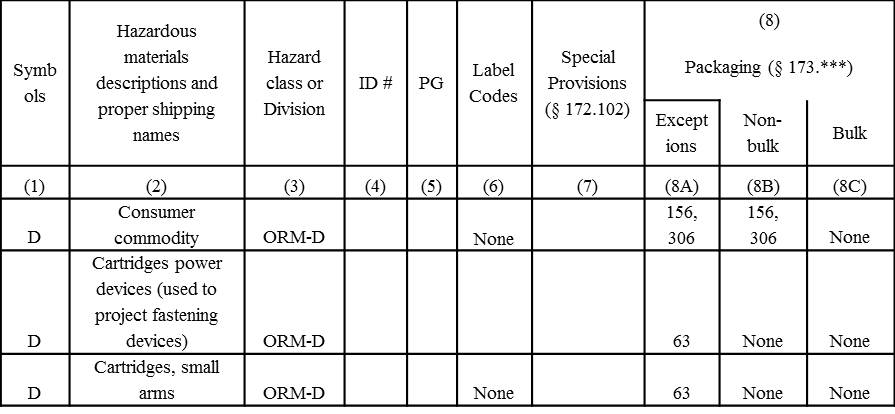49 CFR 171.8 reads, “ORM means other regulated material. See §173.144 of this subchapter.” That’s not much to go on but it’s a start. §173.144 defines an ORM-D as:
Until December 31, 2013 and for the purposes of this subchapter, “ORM-D material” means a material such as a consumer commodity, cartridges, small arms or cartridges, power devices which, although otherwise subject to the regulations of this subchapter, presents a limited hazard during transportation due to its form, quantity and packaging. It must be a material for which exceptions are provided in Column (8A) of the § 172.101 Hazardous Materials Table.
Editors Note: Though originally slated to expire December 31, 2013, the phase-out date for the ORM-D hazard class and the Consumer Commodity exception has now been extended until December 31, 2020.
Read: Authorization for use of the ORM-D classification and the Consumer Commodity Exception extended through 2020!

So, §171.8 refers to all ORM, but §173.144 is specific to just ORM-D. It is left unsaid that there used to be five different divisions to the ORM hazard class: ORM-A through ORM-E. Of these five, only ORM-D remains, and its time is limited; thus the inclusion of “Until December 31, 2013…” in the definition.
For now, we’ll continue to focus on the definition of ORM-D, we’ll come back to “Until December 31, 2013…” later. The above definition is found in Subpart D of Part 173 – Definitions Classification, Packing Group Assignments and Exceptions for Hazardous Materials Other Than Class 1 and Class 7. Notice then that ORM-D is a type of Hazard Class, similar to Class 3 – Flammable and Combustible Liquid and Class 8 – Corrosive Material. And, contrary to what you’ve been told, the “D” in ORM-D does not stand for Domestic. It merely distinguishes it from the other ORM’s that used to exist.
Per the definition, an ORM-D is a hazardous material that normally would be subject to all the requirements of the Hazardous Material Regulations (HMR) but due to its (1) form, (2) quantity, and (3) packaging presents a limited risk in transportation. All three of those conditions must be met for a HazMat to be re-classed as an ORM-D.
Hazardous Materials that are applicable to be re-classed as an ORM-D are limited to the following:
- Consumer Commodity.
- Cartridges, small arms.
- Cartridges, power devices.
In addition to the above list, the ORM-D exception is available only if a section of Part 173 is referenced in Column 8A of the Hazardous Materials Table (49 CFR 172.101). For example, the Hazardous Material Table entries for the above ORM-D’s reads:
So, to learn the packaging exceptions available for a Consumer Commodity classed as an ORM-D, you refer to 49 CFR 173.156 or §173.306 (the sections of Part 173 referenced in column 8A of the Hazardous Materials Table). For Cartridges, Power Devices and Cartridges, Small Arms, you refer to §173.63.
Benefits to the re-classification of a hazardous material as an ORM-D include:
- No placards.
- No labels unless shipped by air.
- No shipping paper unless shipped by air or vessel.
- No packing group or identification number.
- Specification packaging not required as long as applicable packaging requirements are met.
The biggest drawback to using the ORM-D Hazard Class is that it is not recognized by international regulations. To address this the US DOT is in the middle of a phase out of the Consumer Commodity Exception and the ORM-D hazard class.
Editors Note: Though originally slated to expire December 31, 2013, the phase-out date for the ORM-D hazard class and the Consumer Commodity exception has now been extended until December 31, 2020.
Read: Authorization for use of the ORM-D classification and the Consumer Commodity Exception extended through 2020!
The HMR is always changing, and no one will let you know of the changes until it is too late. Stay on top of these changes by attending my Seminar Training, scheduling Onsite Training, or attending a Webinar. It will bring you into compliance and inform you of what you need to do to stay in compliance in the future.
Daniels Training Services 815.821.1550 |


